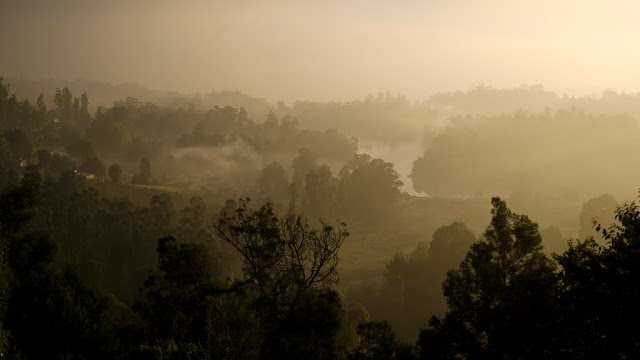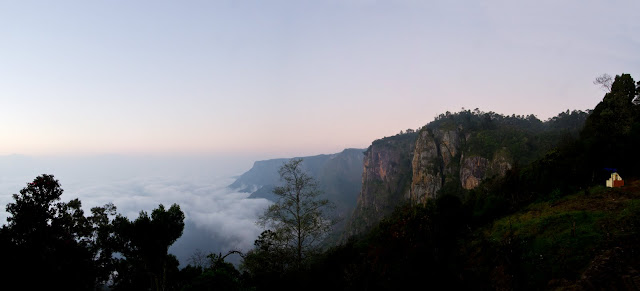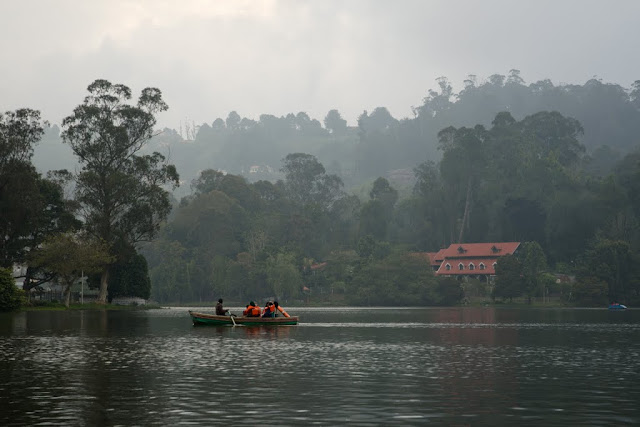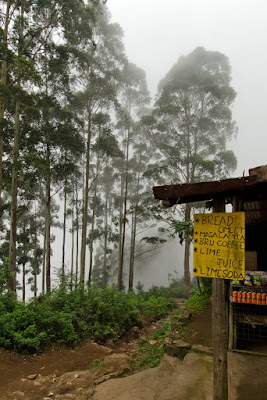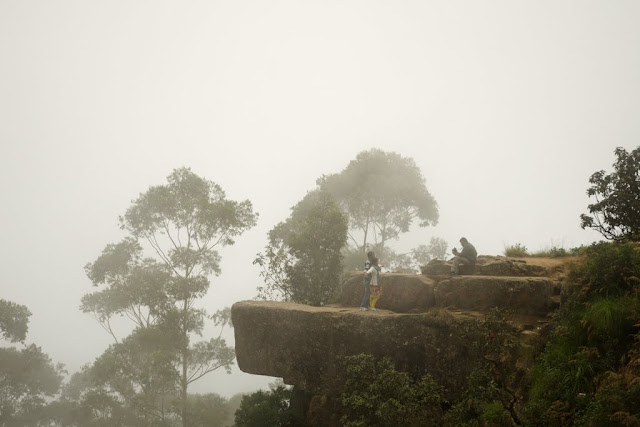I spent all of 2016 wishing I could travel more, and feeling that I hadn’t travelled much. Penning these travel memories down has made me realise that I have indeed travelled a fair bit this year, and a few trips had actually just slipped under my radar because they were disguised as ‘work’ or ‘wedding trips’ or ‘just going home’. I visited many cities and metropolises this year, something I don’t do too often, as I seek tranquil places most of the time. 2015’s food theme did continue strong this year. I also managed to visit places that had been on my travel wish-list since many years, some literally since my childhood! To top it all, I finally set foot in the northern Himalayas, having only travelled to the eastern Himalayas before. What more can I say? I’m ending 2016 on a cheerful and nostalgic note!
Here's hoping that 2017 brings this beautiful world of
ours some much-needed happiness and peace.
Ranthambore National Park
A last minute travel plan to a national park which is
notorious for being booked out months in advance should logically never work
out; fortuitously, it did! Though my late booking meant that my safaris weren’t
in any of the zones with Ranthambore’s famous monuments, or even the Rajbagh
Lake, this trip gave me a fair idea of the forest’s unique topography. And I
did see one of Ranthambore’s gorgeous tigresses.
My guide to visiting Ranthambore: http://nomadandabag-guides.blogspot.com/2017/05/ranthambore-national-park-information.html
Bharatpur & Chambal
When wildlife tours to Bharatpur were called
'Magical Bharatpur', I dismissed the description as just another tagline.
Having visited Bharatpur now, I can vouch for the magic, and can say that
'magical' doesn't do the place enough justice. Beginning each of my three days
with foggy rides in cycle-rickshaws at dawn, and ending them with
multi-coloured sunsets, there wasn’t a dull moment spent at the Keoladeo Ghana
National Park. For me, the highlight of the trip was witnessing an
out-of-season mating dance by a Sarus Crane pair; the love they expressed for
each other was – you guessed it – magical! I also visited nearby Chambal on a
day-trip, finally seeing the region’s infamous ravines, the Chambal River, toothy
Gharials, and the endangered Indian Skimmers.
Jaipur
Jaipur fell into place by accident, when I decided
to fly in and out of the city while visiting Ranthambore and Bharatpur. Never
one to miss chances like these, I decided to spend a day in Jaipur, for my
first taste of the city which had been on my wish-list ever since I was
enamoured by a cut-out of the Hawa Mahal as a child. A day is way too short for
a holiday, but I thoroughly enjoyed ambling around the old city’s vibrant
bazaars and monuments, gorging on local delicacies which my host had painstakingly
listed for me. And of course, I fell in love with Hawa Mahal all over
again.
Kolkata
When a friend announced that her wedding would be in
Kolkata, I lost no time in planning an extended trip to the ‘City of Joy’. With
a little over two days at hand for enjoying the city, I splurged to stay at the
Oberoi, in the heart of Kolkata, with all the landmarks just a stone’s throw
away. The city is immensely easy to negotiate by walking, using the metro, or
the classic yellow taxis (my personal favourites), though my friends didn’t
really share my enthusiasm for these slow and rickety behemoths. We visited some of Kolkata’s classic landmarks, enjoyed Park Street’s weekend vibe, ate ghoti gorom while walking along the
ghats of the Hooghly River, and over-dosed on authentic Bengali mishti, which has spoiled any mishti outside of Bengal for us.
Kolkata’s street food was a revelation: delicious, available at every corner of
the city, and light on the wallet.
Malnad
region, Karnataka
I was grumpy during summer, due to my lack of travel
plans because of having just recovered from a back injury. A sudden call from
my wildlife mentor to travel to Sagar and Shimoga districts in the Malnad
region had me bounding out of bed. With promises to my family that I would be
extra cautious about my back, I set out on this four-day trip through lush
forests and rolling hills, appreciating some lesser-known wildlife areas. The
beautiful Jain temple at Nagarabasti, surrounded by verdant vistas, was a find.
It drizzled incessantly throughout the trip; however, the famed Jog Falls was
bone-dry, much to my dismay!
An account of my visit to the Sakrebyle Elephant Camp near Shimoga:
http://nomadandabag.blogspot.com/2017/05/sakrebyle-elephant-camp.html
Mumbai
Home to me, but an intriguing metropolis to my husband, Mumbai (still Bombay to me) was a sudden trip in summer. What lured hubby and sealed the deal was the promise of Alphonso mangoes every day. I used this opportunity to walk around all my favourite hangouts in the city, with weary hubby trudging along in the muggy May heat. Exploring the Fort region to the CBD, Marine Drive to the Gateway of India, Juhu beach to Dadar, I relived my life as a Mumbaikar. Of course, how could food be far behind? Authentic Maharashtrian dishes, Irani restaurants, Gujarati food and Bambaiyya dishes, we savoured them all, washed down with copious cups of aamras and mango milkshakes. By the end of the holiday, my husband was a convert.
BR
Hills, Karnataka
I’ve visited this forest many times, and the JLR property at K.Gudi is one of my favourites. Since my husband had never been there, we decided to take a short break mid-year. The probability of encountering elephants along the forest’s narrow, winding, hilly safari route always excites and scares me in equal measure. This trip, to add to our excitement was the cottage we had chosen to stay in – farthest from the other cottages, and where leopards are routinely sighted. One of our most memorable experiences was sitting in our stilted cottage’s balcony after 10 pm, in pitch darkness, surrounded by bats and fireflies, listening to frequent alarm calls and the rustling of leaves. Sometimes, the things you can only hear scare you more than the things you can see.
I’ve visited this forest many times, and the JLR property at K.Gudi is one of my favourites. Since my husband had never been there, we decided to take a short break mid-year. The probability of encountering elephants along the forest’s narrow, winding, hilly safari route always excites and scares me in equal measure. This trip, to add to our excitement was the cottage we had chosen to stay in – farthest from the other cottages, and where leopards are routinely sighted. One of our most memorable experiences was sitting in our stilted cottage’s balcony after 10 pm, in pitch darkness, surrounded by bats and fireflies, listening to frequent alarm calls and the rustling of leaves. Sometimes, the things you can only hear scare you more than the things you can see.
Chandigarh
For an architect, Chandigarh is something of a holy
grail. When I planned my trip to Spiti Valley, I jumped at the opportunity to
spend a day there. My impression of the city, garnered mostly from school textbooks
and architecture books, now sprung alive. In just a few hours, Chandigarh
bowled me over with its cleanliness, orderly traffic, soft-spoken people, and
joie de vivre. Nek Chand’s Rock Garden was a childhood dream come true, and
every bit as crazy as I had imagined! Seated on the bund at Sukhna Lake, legs
swinging over the edge, surrounded by locals enjoying the tranquility, I could
see why Chandigarh’s residents love their city; I love it too!
Lahaul
and Spiti, Himachal Pradesh
My trip to Spiti Valley was one of the highlights of the second half of the year, and I returned smitten by the beauty of the region, the stark landscapes, its ever-smiling people, their hospitality, and their simplicity of life. Spiti is raw nature at its best, and its worst; yet, the locals embrace everything as a part of life. Involving high-altitude travel on gravelly roads where traversing 200 kms takes 12 hours, the tranquility of Spiti’s tiny villages, the sparkling azure of its lakes, and the serenity of its monasteries are some of the many memories etched in my mind. Since my return, I remain deeply introspective.
My trip to Spiti Valley was one of the highlights of the second half of the year, and I returned smitten by the beauty of the region, the stark landscapes, its ever-smiling people, their hospitality, and their simplicity of life. Spiti is raw nature at its best, and its worst; yet, the locals embrace everything as a part of life. Involving high-altitude travel on gravelly roads where traversing 200 kms takes 12 hours, the tranquility of Spiti’s tiny villages, the sparkling azure of its lakes, and the serenity of its monasteries are some of the many memories etched in my mind. Since my return, I remain deeply introspective.
Hampi
Hampi never ceases to surprise me, even on my third trip! Having seen some of the main monuments on a ‘fun only’ first trip with a bunch of friends, and Hampi’s and Daroji’s wildlife on my second trip, I was third time lucky. With an excellent guide and lovely accommodation in serene Anegundi, I brought in my birthday just the way I liked it – walking all day through the treasure hunt that is Hampi, stumbling across picturesque ruins, pristine banks of the Tungabhadra River, and negotiating through herds of goats. Hampi’s scale is staggering, and this is the closest I have come to feeling like Indiana Jones. Hampi’s vast expanse also meant that in spite of the Dusshera holiday crowds, I always managed to find a quiet spot for myself.
Hampi never ceases to surprise me, even on my third trip! Having seen some of the main monuments on a ‘fun only’ first trip with a bunch of friends, and Hampi’s and Daroji’s wildlife on my second trip, I was third time lucky. With an excellent guide and lovely accommodation in serene Anegundi, I brought in my birthday just the way I liked it – walking all day through the treasure hunt that is Hampi, stumbling across picturesque ruins, pristine banks of the Tungabhadra River, and negotiating through herds of goats. Hampi’s scale is staggering, and this is the closest I have come to feeling like Indiana Jones. Hampi’s vast expanse also meant that in spite of the Dusshera holiday crowds, I always managed to find a quiet spot for myself.













